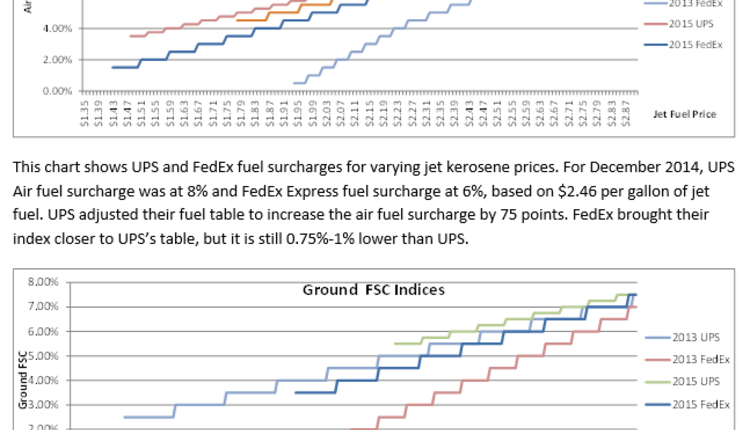As a transportation or logistics manager, one of your many responsibilities includes making sure your parcel contracts are in good shape, which covers having favorable rates and lowering risks and liabilities. The average parcel contract gets negotiated or reviewed every two to three years. Between each negotiation, there are significant changes in the carriers’ rules. This article will cover some of the changes that took place in recent years.
List Rates
UPS has two different sets of published rates. “Daily Rates” is the more favorable rate sheet, and it is offered to shippers that have been UPS shippers since before 2011. “Standard Rates” are offered to newer shippers. When comparing two contracts, this small detail will cause a major gap between the total spend.
Also, you should know that FedEx and UPS list rates are different. On the Ground service (and Home Delivery for FedEx), the rates are identical up to 70 pounds. Above 70 pounds, there is a five cent difference. However on air services, the two carriers’ list rates are completely different. As a result, the same level of discount from each carrier would not yield the same net spend.
Fuel Surcharges
Historically, UPS and FedEx have been using an identical fuel index, which meant that their Air and Ground fuel surcharges (FSC) were the same. Last November, UPS shifted its fuel index, which resulted in a delta between the UPS and FedEx FSC. At lower fuel prices, the UPS FSC is higher compared to FedEx. At higher fuel prices, the UPS fuel surcharge is lower. If you are comparing proposals from the two carriers, you need to keep this gap in mind. As of August 2013, the UPS Air FSC is 1.5% higher than FedEx.
Postal Consolidated Services
Both Surepost and Smartpost are lower price services with no service guarantees that are usually one day slower than the Ground service. The parcel carriers drop the packages to the US Postal Service Destination Delivery Unit (DDU), and the USPS performs last mile delivery. The ideal packages for these services are low weight (less than 10 pounds) and low priority, where a late package will not upset the recipient. These services are offered to select shippers with significant volumes directed to these services. Until recently, there was no surcharge (besides the FSC) that applied to these services. However in 2013, both UPS and FedEx started applying Delivery Area and Extended Delivery Area surcharges ($0.25 to $0.30) to packages that were being delivered by the USPS. The logic behind this surcharge is highly questionable; however, the shippers should be aware that they will end up paying more for these services.
Dimensional Weights
Both FedEx and UPS switched to using dimensional weights many years ago. However, the list dimensional factor keeps going down, causing the rated weights for your packages to go up. There is not a way to get away from dimensional weights; however, you should try to reduce the damage by taking a few steps. First, you should optimize your box sizes so you do not pay for shipping air. Next, you should negotiate a higher DIM factor, and if it makes sense, a threshold for the cubed packages.
Agreement Terms
Carriers are trying to push terms in the agreement that tie the shippers’ hands. Early termination penalties prevent the shipper from switching carriers or even renegotiating the agreement before three years pass after the agreement is signed. In most cases, this time is too long, and it creates an unnecessary risk for the shipper. There are already terms in the parcel contract that tie the incentives to the parcel spend so that the shipper keeps the business with the carrier.
Another clause often added to agreement terms is the guaranteed service waiver. The shippers pay a premium for their packages to arrive at a specific time. The Guaranteed Service Refund is one way to keep the carriers accountable for being timely, and you should not give away that right.
Summary
Parcel carriers come up with new services, new rules, and new surcharges regularly. While negotiating or reviewing your parcel contract or while comparing proposals from two carriers, you should carefully read the service guides and the agreements and understand the terms you are signing to avoid paying more and to prevent long-term grief.
Baris Tasdelen is a Sr. Transportation Analyst with enVista, a leading supply chain consulting and IT services firm, delivering innovative solutions that improve profitability, enhance customer service and reduce waste from source to consumption. enVista’s unrivaled consulting experience, deep vertical industry expertise and comprehensive solutions portfolio, enable clients to leverage one strategic partner that consults, implements and operates across Supply Chain, Transportation, Retail, IT and ERP.
List Rates
UPS has two different sets of published rates. “Daily Rates” is the more favorable rate sheet, and it is offered to shippers that have been UPS shippers since before 2011. “Standard Rates” are offered to newer shippers. When comparing two contracts, this small detail will cause a major gap between the total spend.
Also, you should know that FedEx and UPS list rates are different. On the Ground service (and Home Delivery for FedEx), the rates are identical up to 70 pounds. Above 70 pounds, there is a five cent difference. However on air services, the two carriers’ list rates are completely different. As a result, the same level of discount from each carrier would not yield the same net spend.
Fuel Surcharges
Historically, UPS and FedEx have been using an identical fuel index, which meant that their Air and Ground fuel surcharges (FSC) were the same. Last November, UPS shifted its fuel index, which resulted in a delta between the UPS and FedEx FSC. At lower fuel prices, the UPS FSC is higher compared to FedEx. At higher fuel prices, the UPS fuel surcharge is lower. If you are comparing proposals from the two carriers, you need to keep this gap in mind. As of August 2013, the UPS Air FSC is 1.5% higher than FedEx.
Postal Consolidated Services
Both Surepost and Smartpost are lower price services with no service guarantees that are usually one day slower than the Ground service. The parcel carriers drop the packages to the US Postal Service Destination Delivery Unit (DDU), and the USPS performs last mile delivery. The ideal packages for these services are low weight (less than 10 pounds) and low priority, where a late package will not upset the recipient. These services are offered to select shippers with significant volumes directed to these services. Until recently, there was no surcharge (besides the FSC) that applied to these services. However in 2013, both UPS and FedEx started applying Delivery Area and Extended Delivery Area surcharges ($0.25 to $0.30) to packages that were being delivered by the USPS. The logic behind this surcharge is highly questionable; however, the shippers should be aware that they will end up paying more for these services.
Dimensional Weights
Both FedEx and UPS switched to using dimensional weights many years ago. However, the list dimensional factor keeps going down, causing the rated weights for your packages to go up. There is not a way to get away from dimensional weights; however, you should try to reduce the damage by taking a few steps. First, you should optimize your box sizes so you do not pay for shipping air. Next, you should negotiate a higher DIM factor, and if it makes sense, a threshold for the cubed packages.
Agreement Terms
Carriers are trying to push terms in the agreement that tie the shippers’ hands. Early termination penalties prevent the shipper from switching carriers or even renegotiating the agreement before three years pass after the agreement is signed. In most cases, this time is too long, and it creates an unnecessary risk for the shipper. There are already terms in the parcel contract that tie the incentives to the parcel spend so that the shipper keeps the business with the carrier.
Another clause often added to agreement terms is the guaranteed service waiver. The shippers pay a premium for their packages to arrive at a specific time. The Guaranteed Service Refund is one way to keep the carriers accountable for being timely, and you should not give away that right.
Summary
Parcel carriers come up with new services, new rules, and new surcharges regularly. While negotiating or reviewing your parcel contract or while comparing proposals from two carriers, you should carefully read the service guides and the agreements and understand the terms you are signing to avoid paying more and to prevent long-term grief.
Baris Tasdelen is a Sr. Transportation Analyst with enVista, a leading supply chain consulting and IT services firm, delivering innovative solutions that improve profitability, enhance customer service and reduce waste from source to consumption. enVista’s unrivaled consulting experience, deep vertical industry expertise and comprehensive solutions portfolio, enable clients to leverage one strategic partner that consults, implements and operates across Supply Chain, Transportation, Retail, IT and ERP.









